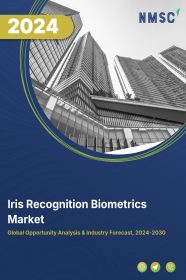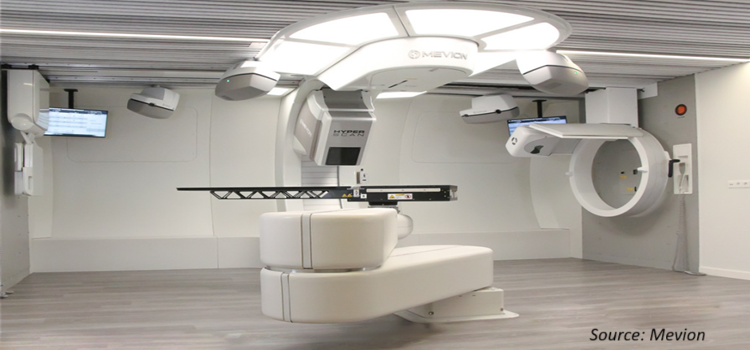
Iris Recognition Biometrics Market by Product Type (Smartphones, Wearables, Tablets & Notebooks, PCs & Laptops, Scanners, and Others), by Component (Hardware and Software), by Application (Identity Management and Access Control, Time Monitoring, and E-Payment), and by End User (Government, Military & Defense, Healthcare, Banking & Finance, Consumer Electronics, Travel & Immigration, Automotive, and Others) – Global Opportunity Analysis and Industry Forecast 2024-2030
US Tariff Impact on Iris Recognition Biometrics Market
Trump Tariffs Are Reshaping Global Business
Market Definition
The Iris Recognition Biometrics Market size was valued at USD 4.93 billion in 2023 and is predicted to reach USD 18.63 billion by 2030 with a CAGR of 20.8% from 2024-2030. The iris recognition biometrics industry focuses on leveraging iris recognition technology for authentication and identification purposes by analyzing unique patterns in the iris, this biometric method offers a highly secure and accurate means of verifying an individual's identity. The technology works by capturing high-resolution images of the iris, which are then processed and compared against stored templates in a database. Iris recognition is widely used in various sectors, including government, law enforcement, healthcare, banking, and border control, due to its reliability and resistance to fraud or forgery. With advancements in machine learning and image processing algorithms, the iris recognition biometrics industry continues to evolve, offering improved accuracy, speed, and scalability for various applications requiring robust identity verification solutions.
Market Dynamics and Trends
The rising demand for iris recognition biometrics is due to the growing adoption of the National ID program that provides identification and authentication of citizens within the nation globally. It helps to prevent duplicate registrations for convenient purposes such as passport and voter registration. For instance, the Government of India has adopted iris-based biometric national ID cards by capturing biometric data inputs such as fingerprint and iris that serves as proof of identity and address in India.
Also, the increasing tourism coupled with threats of terrorism in countries such as China and India enable iris recognition solutions to tighten immigration control and contributes to a safer society by providing improved security and smooth personal identification is expected to further propel the growth of iris recognition biometrics market.
Moreover, growing use of iris recognition technology is high in the healthcare sector that provides a highly accurate way to authenticate an individual and provides non-contact hygienic personal identification. It also provides correct dispensing of right drug and correct treatment to the right patient across countries, which has resulted in greater utilization of iris recognition biometrics during the forecast period.
However, high cost of biometric equipment and lack of skilled professionals to use the devices are the factors that are expected to restrain the growth of market during the forecast period. On the contrary, the integration of Iris recognition biometrics with Internet of Things (IoT) devices and smart city infrastructure to enhance security, automate processes, and improve public safety, is expected to create ample growth opportunities for the market in the coming years.
Market Segmentations and Scope of the Study
The iris recognition biometrics market share is segmented on the basis of product type, component, application, end user, and region. On the basis of product type, the market is divided into smartphones, wearables, tablets & notebooks, PCs & laptops, scanners, and others. On the basis of components, the market is classified into hardware and software. On the basis of application, the market is categorized into identity management and access control, time monitoring, and e-payment. On the basis of end users, the market is bifurcated into government, military & defense, healthcare, banking & finance, consumer electronics, travel & immigration, automotive, and others. Regional breakdown and analysis of each of the aforesaid segments include regions comprising North America, Europe, Asia-Pacific, and RoW.
Geographical Analysis
North America holds the dominating share of iris recognition biometrics market and is expected to continue its dominance during the forecast period. This is attributed to factors such as improved infrastructure and growing use of biometrics by the government for safety and security in this region.
For instance, the federal government announced growing use of iris biometrics for the collection of personal identity and authentication data by joining Iris ID. The various agencies such as the Department of Homeland Security and the Federal Bureau of Investigation (FBI) are investigating iris-based technology for uses such as identifying people crossing U.S. borders and processing passengers at airport security checkpoints.
Also, the presence of major key players such as Aware Inc., Iris ID Inc., Iritech Inc. and HID Global that has entered into strategic agreements boosts the market growth in this region. For instance, Iris ID introduced two biometric scanners designed for travel hubs at Intersec 2022, combining iris and facial recognition technologies to streamline travel processes at airports and border crossings.
On the other hand, Asia-Pacific is expected to show a steady rise in the iris recognition biometric market due to increasing adoption of iris biometric tools among governments and law enforcement agencies in this region. For instance, in March 2022, in Pakistan, the National Database and Registration Authority (NADRA) opened 88 new centers to facilitate the registration of digital ID registration for citizens.
Moreover, growing population preference for touchless and hygienic biometric devices such as iris recognition to access control applications among the population across countries in this region is expected to drive the iris recognition biometric market.
For instance, Iris Scanners Technologies Pvt. Ltd. announced a distribution agreement with EyeLock LLC in India. This new partnership leveraged IrisScanners extensive distribution network in India for biometric access control solutions. This agreement allowed distribution rights for the entire Eyelock product line, including iXT and EyeLock ID that focusing on the distribution area in India.
Competitive Landscape
The iris recognition biometrics market trend comprising of various market players such as IDEMIA, IrisGuard, EyeLock, Iris ID, Princeton Identity, CMITech Company, Hoyos Labs, Cognitec Systems, BioEnable Technologies, Human Recognition Systems, and others. These market players are adopting various achievements and joint ventures of business across various regions to maintain their dominance in the high-purity aluminum market.
For instance, in January 2024, EyeLock unveiled state-of-the-art biometric security systems integrated with Passkey authentication technology, marking a significant advancement in secure authentication for the digital era.
Moreover, in March 2023, IDEMIA introduced two new cutting-edge contactless on-the-move biometric devices, showcasing the company's leadership in accurate identity capture and verification. These innovative products incorporate advanced biometric algorithms, highlighting IDEMIA's commitment to continuous improvement and innovation in the market.
Key Benefits
-
The iris recognition biometrics market report provides the quantitative analysis of the current market and estimations through 2024-2030 that assists in identifying the prevailing market opportunities to capitalize on.
-
The study comprises a deep dive analysis of the iris recognition biometrics market trend including the current and future trends for depicting the prevalent investment pockets in the market.
-
The information related to key drivers, restraints and opportunities and their impact on the iris recognition biometrics market is provided in the report.
-
The competitive analysis of the market players along with their market share in the iris recognition biometrics market
-
The SWOT analysis and Porters Five Forces model is elaborated in the study.
-
Value chain analysis in the market study provides a clear picture of the stakeholders’ roles.
Key Market Segments
By Product Type
-
Smartphones
-
Wearables
-
Tablets & Notebooks
-
PCs & Laptops
-
Scanners
-
Others
By Component
-
Hardware
-
Software
By Application
-
Identity management and Access Control
-
Time Monitoring
-
E-Payment
By End User
-
Government
-
Military & Defense
-
Healthcare
-
Banking & Finance
-
Consumer Electronics
-
Travel & Immigration
-
Automotive
-
Others
By Region
-
North America
-
The U.S.
-
Canada
-
Mexico
-
-
Europe
-
The UK
-
Germany
-
France
-
Italy
-
Spain
-
Denmark
-
Netherlands
-
Finland
-
Sweden
-
Norway
-
Russia
-
Rest of Europe
-
-
Asia-Pacific
-
China
-
Japan
-
India
-
South Korea
-
Australia
-
Indonesia
-
Singapore
-
Taiwan
-
Thailand
-
Rest of Asia-Pacific
-
-
RoW
-
Latin America
-
Middle East
-
Africa
-
Key players
-
IDEMIA
-
IrisGuard
-
EyeLock
-
Iris ID
-
Princeton Identity
-
CMITech Company
-
Hoyos Labs
-
Cognitec Systems
-
BioEnable Technologies
-
Human Recognition Systems
REPORT SCOPE AND SEGMENTATION:
|
Parameters |
Details |
|
Market Size in 2023 |
USD 4.93 Billion |
|
Revenue Forecast in 2030 |
USD 18.63 Billion |
|
Growth Rate |
CAGR of 20.8% from 2024 to 2030 |
|
Analysis Period |
2023–2030 |
|
Base Year Considered |
2023 |
|
Forecast Period |
2024–2030 |
|
Market Size Estimation |
Billion (USD) |
|
Growth Factors |
|
|
Countries Covered |
28 |
|
Companies Profiled |
10 |
|
Market Share |
Available for 10 companies |
|
Customization Scope |
Free customization (equivalent up to 80 working hours of analysts) after purchase. Addition or alteration to country, regional, and segment scope. |
|
Pricing and Purchase Options |
Avail customized purchase options to meet your exact research needs. |

















 Speak to Our Analyst
Speak to Our Analyst





















